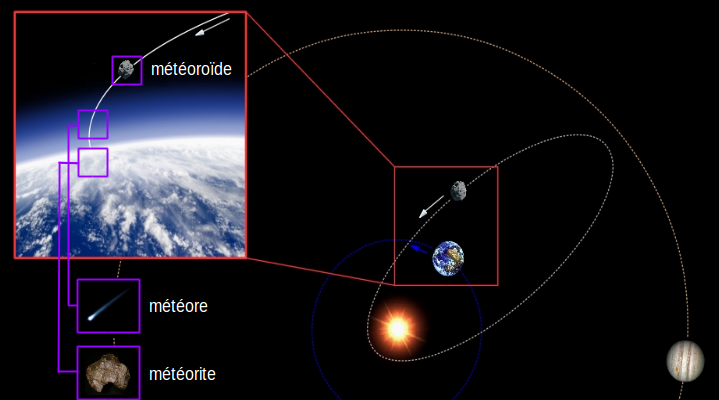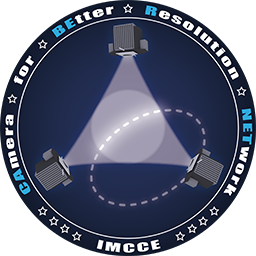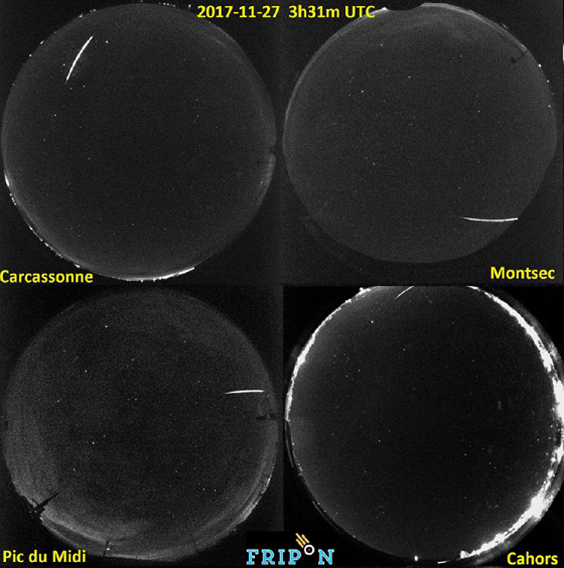Meteors, meteorites and meteoroids streams
Presentation
Meteoroids are small sized bodies (30 μm-1 m) originating from the partial disaggregation of comets or asteroids which are then called their parent bodies. Sometimes grouped into swarms in interplanetary space, these objects result during collisions with the Earth in the appearance of atmospheric luminous phenomenons, called meteors, that we have the opportunity to admire throughout the year. The majority of meteoroids does not survive when entering the terrestrial atmosphere, and they are then generally only visible for a few fractions of a second. Despite this speed, it is sometimes possible to observe them with enough precision to try to determine their orbital origin and search for their parent body. If a meteoroid is massive enough to survive to the atmospheric reentry, it is possible to find some of its fragments on the ground (called meteorites).
The study of meteors, meteoroids and meteorites and the knowledge of their origin provide essential information which makes it possible to constrain the composition, formation and evolution of the Solar System. Unfortunately, the identification of parent bodies of meteor showers is complex and often unsuccessful. Thus, only around 20 % of meteor showers established by the International Astronomic Union (UAI) have been related to a clearly identified parent body. The prediction of the next observable meteor showers on Earth, which can also be a threat to communication satellites and manned space missions, is therefore only possible for this small fraction of identified showers.

Research activities
The ACME research team is actively involved in the main meteors observation and study projects conducted by the IMCCE: CABERNET and FRIPON.
CABERNET
 The “CAmera for BEtter Resolution NETwork” (CABERNET) project was set up in 2011 to observe meteor showers. The main purposes of this network are to study the origin of the meteors captured (search for parent bodies) and to improve the accuracy of the meteor showers prediction. The network is composed by three ultra-sophisticated CCD cameras, operational since 2013 in the Pyrénées region. The accuracy of the data recorded by the cameras allow to considerably reduce the uncertainty on the calculated meteoroid orbits, which is essential to identify the parent bodies of the meteors captured by the network.
The “CAmera for BEtter Resolution NETwork” (CABERNET) project was set up in 2011 to observe meteor showers. The main purposes of this network are to study the origin of the meteors captured (search for parent bodies) and to improve the accuracy of the meteor showers prediction. The network is composed by three ultra-sophisticated CCD cameras, operational since 2013 in the Pyrénées region. The accuracy of the data recorded by the cameras allow to considerably reduce the uncertainty on the calculated meteoroid orbits, which is essential to identify the parent bodies of the meteors captured by the network.
FRIPON
The “Fireball Recovery and InterPlanetary Observation Network” (FRIPON) covers the whole French territory. The main goal of the network is to detect any meteorite fall occuring in the metropolitan France, and to observe their trajectory with enough accuracy to determine their orbital origin and their parent body. Thanks to the deployment of a hundred cameras, FRIPON is the world’s densest meteor observation network in such a vast territory. The predictions for the project are to harvest one to two meteorites strewn fields per year.

Last update Friday 19 June 2020